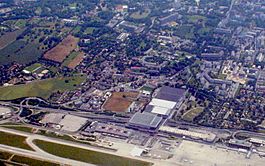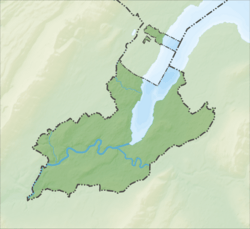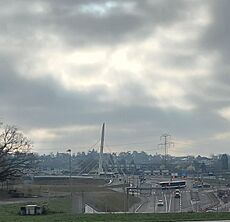Le Grand-Saconnex facts for kids
Quick facts for kids
Le Grand-Saconnex
|
||
|---|---|---|
 |
||
|
||
| Country | Switzerland | |
| Canton | Geneva | |
| District | n.a. | |
| Area | ||
| • Total | 4.38 km2 (1.69 sq mi) | |
| Elevation | 452 m (1,483 ft) | |
| Population
(Dec 2020 )
|
||
| • Total | 12,378 | |
| • Density | 2,826/km2 (7,319/sq mi) | |
| Postal code |
1218
|
|
| Surrounded by | Bellevue, Ferney-Voltaire (FR-01), Geneva (Genève), Meyrin, Pregny-Chambésy, Vernier | |
| Twin towns | Carantec (France) | |
Le Grand-Saconnex is a town in the Canton of Geneva, Switzerland. It's known for being a very international place. Many global organizations and offices for the United Nations are located here.
Because of these international groups, Le Grand-Saconnex has a very diverse population. Almost 40% of the people living here were born outside of Switzerland!
Part of the Geneva Airport is also located within Le Grand-Saconnex.
Contents
History of Le Grand-Saconnex
Le Grand-Saconnex was first mentioned in old records in the year 1128. Back then, it was called Saconai.
Geography of Le Grand-Saconnex
Le Grand-Saconnex covers an area of about 4.38 square kilometers (about 1.69 square miles). A good part of this land, about 83.6%, is built up with buildings and roads.
About 14.2% of the land is used for farming. This includes fields for crops and areas for orchards. A small part, about 2.1%, is covered by forests.
The town is located just west of the city of Geneva. It's also on the right side of Lake Geneva. Le Grand-Saconnex is made up of several smaller areas or villages. These include Aéroport - Arena, Les Blanchets, and Le Pommier.
Population and Languages
Le Grand-Saconnex has a population of over 12,000 people. It's a growing town, with its population increasing by about 37% between 1999 and 2009.
Many different languages are spoken here. Most people (about 71%) speak French. English is the second most common language, spoken by about 6.8% of the people. German is third, spoken by about 4.6%.
The town is very international. In 2008, about 43.6% of the people living in Le Grand-Saconnex were foreign nationals. This means they were born outside of Switzerland.
Most of the population is made up of adults between 20 and 64 years old. Children and teenagers (0-19 years old) make up about 22.6% of the population.
The chart below shows how the population has grown over the years:

Important Heritage Sites
Le Grand-Saconnex is home to some very important buildings. The World Council of Churches with its Archives is listed as a Swiss heritage site. The UNESCO Centre de documentation is also a nationally important site.
Twin Towns
Le Grand-Saconnex has a special friendship with another town. This is called "town twinning."
Economy and Jobs
Le Grand-Saconnex is a busy place for business. The Geneva Airport is partly located here, which brings many jobs and visitors.
Another important place is Palexpo. This is Geneva's big convention center. It's right next to the airport. Palexpo hosts many large exhibitions every year. Some of the most famous events include the Geneva Motor Show and the Salon du livre (Book Fair).
In 2008, there were over 8,000 full-time jobs in Le Grand-Saconnex. Most of these jobs were in the "tertiary sector." This includes jobs in sales, transportation, hotels, restaurants, and healthcare.
Many people also travel to Le Grand-Saconnex for work. About 25% of workers use public transportation, while about 55% use a private car to get to work.
Religion in the Community
In 2000, about 35.8% of the people in Le Grand-Saconnex were Roman Catholic. About 17.6% belonged to the Swiss Reformed Church.
The town also has people who follow other religions. About 5.4% of the population was Islamic, and about 0.57% was Jewish. There are also people who are Buddhist and Hindu.
The Ecumenical Centre is located in Le Grand-Saconnex. This center houses the offices of several important religious organizations. These include the World Council of Churches and the Lutheran World Federation.
Education in Le Grand-Saconnex
Education is very important in Le Grand-Saconnex. Many people have completed higher education. About 26.9% of the population has finished upper secondary education. Another 22.8% have completed university or other higher education.
The school system in Geneva offers two years of non-mandatory Kindergarten for young children. After that, students attend six years of primary school. Then, they go to secondary school for three required years, followed by three to five years of optional advanced schooling.
A special school called Campus des Nations opened in Le Grand-Saconnex in 2005. This is one of the campuses of the International School of Geneva. It offers classes for students from age 1 up to age 13. The school uses the International Baccalaureate program, which is a well-known international education system.
The Campus des Nations is located near many important international organizations. These include the International Labor Organization (ILO) and the World Health Organization (WHO).
International Relations
Because of its international nature, Le Grand-Saconnex hosts some foreign offices. For example, the Portuguese consulate in Geneva is located here.
Notable People from Le Grand-Saconnex
Some famous people have connections to Le Grand-Saconnex:
- Johann Jacob Schweppe (1740-1821) was the person who created the famous Schweppes drink.
- Edouard Sarasin (1843–1917) was a scientist and also served as the mayor of Le Grand-Saconnex for many years (1871-1916).
- Bruno Boscardin (born 1970) is a former Swiss racing cyclist who was born in Le Grand-Saconnex.
See also
 In Spanish: Le Grand-Saconnex para niños
In Spanish: Le Grand-Saconnex para niños





